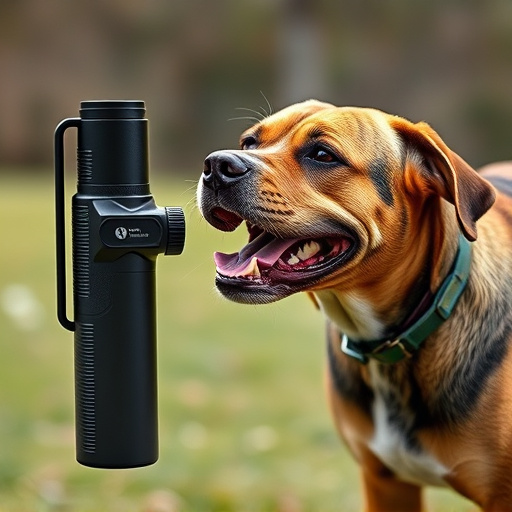Dog spray effectiveness hinges on capsaicin content, a chili pepper compound that deters aggression by irritating mucous membranes. Pet owners should compare capsaicin levels across brands and product types to select a dog spray that balances safety and potency. Higher capsaicin concentrations offer stronger, longer-lasting deterrents for stubborn dogs or larger areas, but must be chosen cautiously to avoid harm. Responsible use involves targeted application, training, and secure storage to prioritize pets' well-being while achieving desired behavior outcomes.
“Uncover the power of dog spray as a safe and effective deterrent in this comprehensive guide. Understanding how dog spray works involves delving into its active ingredient, capsaicin—the key to its success. We’ll compare top dog spray brands, their ingredients, and safety considerations for pet owners. Explore the science behind capsaicin content and its impact on behavior modification. By the end of this article, you’ll be equipped with knowledge to make informed decisions regarding canine deterrents.”
- Understanding Dog Spray: How Does It Work?
- Capsaicin Content: The Key to Effectiveness
- Comparing Dog Spray Brands and Their Ingredients
- Safe Use and Considerations for Pet Owners
Understanding Dog Spray: How Does It Work?
Dog spray, also known as pepper spray for dogs, is a safe and effective deterrent designed to protect against aggressive canine behavior. Its primary active ingredient is capsaicin, a compound found in chili peppers that triggers a burning sensation when it comes into contact with the eyes, nose, and mouth. Unlike traditional pepper spray used by law enforcement, dog spray is specifically formulated to be non-lethal and targeted at the sensitive areas of a dog’s face.
The capsaicin content in dog spray varies widely between brands and types. Typically, a higher concentration of capsaicin means a more potent effect. When sprayed, the capsaicin irritates the mucous membranes, causing the dog to experience discomfort, tears, and a temporary inability to breathe through its nose. This reaction serves as a powerful deterrent, encouraging the dog to retreat or stop its aggressive behavior. A thorough comparison of capsaicin content across different dog spray products is essential for pet owners to ensure they choose an effective yet safe solution for their canine companion.
Capsaicin Content: The Key to Effectiveness
Dog spray’s effectiveness hinges on its capsaicin content, a natural compound found in chili peppers. Higher concentrations of capsaicin create a more intense sting, deterring dogs faster and for longer periods. When comparing different dog sprays, examining the capsaicin content is crucial. While exact percentages vary by brand and product type (e.g., spray, aerosol), a higher concentration generally translates to better results in training and protection scenarios.
A thorough comparison of capsaicin content allows owners to make informed decisions based on their specific needs and the behavior they aim to address. Understanding this key ingredient empowers them to choose a dog spray that offers both safety and efficacy, ensuring a more successful outcome when facing unwanted canine interactions.
Comparing Dog Spray Brands and Their Ingredients
When comparing dog spray brands, one key factor to consider is the capsaicin content. Capsaicin, the active ingredient in chili peppers, is commonly used in dog sprays due to its safe and effective deterrent properties. Different brands may vary significantly in their capsaicin concentration, which directly impacts the spray’s potency and duration. For instance, higher capsaicin content usually means a longer-lasting effect, making it more suitable for larger areas or stubborn dogs.
Moreover, understanding the ingredients used by each brand is crucial. Some dog sprays might include additional components like natural extracts or specific pheromones designed to reduce stress in dogs. A thorough comparison can help pet owners choose a spray that not only effectively deters unwanted behaviors but also aligns with their values, whether it’s opting for more natural formulations or those with enhanced safety features.
Safe Use and Considerations for Pet Owners
When considering dog spray as a deterrent, pet owners must prioritize safety and effectiveness while being mindful of their pet’s well-being. It’s crucial to understand that not all dog sprays are created equal in terms of capsaicin content—the active ingredient responsible for the peppery sensation. A direct comparison of different brands’ capsaicin content is essential to ensure a safe and potent deterrent.
Owner education is key; learning about appropriate application techniques, such as using spray specifically designed for dogs, can prevent accidental harm. Responsible use involves targeting specific behavioral issues in controlled environments. Moreover, regular training sessions can reinforce good behavior without resorting to chemical deterrents. Always store dog spray out of reach of pets and children to avoid accidental exposure.
Dog spray, when used responsibly, can be an effective deterrent to keep dogs away from unwanted areas. Understanding the capsaicin content and comparing different brands is key to choosing a safe and reliable option. By considering the active ingredients and following safe use practices, pet owners can ensure their safety and effectively manage potential canine intrusions. A well-informed choice can go a long way in maintaining a harmonious balance between pets and their surroundings.
